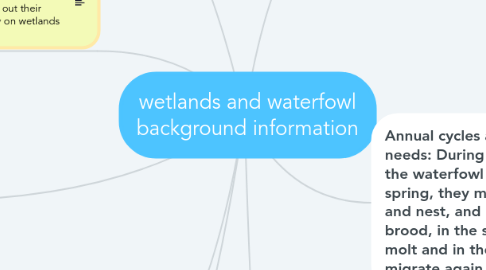
1. drainage has reduced Wetlands from 11 million acres to 3 million acres since Pre-settlement times in Michigan.
2. introduction:waterfowl and wetlands have a very mutualistic bond between them. wetlands cannot be healthy with out waterfowl continually thinning out their vegetation, and waterfowl rely on wetlands for food/water and a habitat.
3. why are wetlands important?
3.1. wetlands house more than 50% of Michigan's plant species and 25% are endangered. Wetlands help reduce flooding by abosorbing rain and snow melt ( 1 acre of wetlands flooded 1ft =330,000 gallons of water. they also filter the run off from fertilizers, pesticides, sediments and other stuff to improve water clarity.
3.2. can help recharge water supplies and works in the water cycle. wetlands are also home to many games like ducks and geese and other birds as well as fish
4. what are the threats to wetlands?
4.1. Wetland Regulations: you must have a permit form the government of your state for any construction projects on wetland area you as a person or as a group, must prevent or restrict the degradation of wetland habitats
4.1.1. ducks, geese, and swans come to wetlands during their migration or for a habitat like mallards, ring-neck ducks, ruddy ducks, black ducks, red breasted mergansers, northern shovelers, gad walls, american wigeon and trumpeter swans.
4.1.2. land owners who restore wetlands on their property could entice birds, small mammals, amphibians, retiels , and songbirds to their property. if you wanted to, you could entice a mallard or a blue winged teal couple to your wetland by having grass-dominated wetlands or wood ducks, black ducks or hooded mergansers by having wooded uplands.
5. Management Considerations
5.1. 5; to encourage geese, mow around the wetland. to discourage, don't mow 6;for marshs have a 50;50 ratio of water to plant material and burn a part of the march every three years to help plants regenerate 7;look out for invasive plants and use insecticides that don't harm the invertebrates in or around the wetlands 8; avoid human or animal disturbance to the wetland and waterfowl as this can cause the birds to forgo the breeding process because they lost all their protein running away form you and it can also increase duckling mortality 9; PROTECT ALL WETLANDS AROUND YOUR HOME OR AREA FOR THE WATERFOWL
5.1.1. landowners are warned that the best way to increase the number of waterfowl on their property is to leave any wetlands in a natural state. steps to keeping birds on your property 1: restore any degraded wetlands on your land 2; protect and maintain a buffer 100 ft wide to reduce prodertor impact and increase bird reproduction 3; plant a buffer around the wetland of warm season grasses and cool season grasses like Indian grass, bush clover, and wildflowers 4: maintain a grove of trees like silver maple, sugar maple, basswood,and aspen for cavities for woods ducks, hooded mergansers, and gold eyes while having tree like oak, maple and elm for wood ducks mallards, and black ducks.
6. History: the last great ice age carved up Michigan to make more bodies of water (bogs formed kettle lakes filled with plant derbies). when the Europeans came , the wetlands got mostly drained and were ruined. 11 millions acres of wetlands were destroyed before that was stopped.
6.1. major wetland types
6.1.1. marshes: flooded grasslands grasses, rush weed, cattails, pickeral weed and smart-weed water fowl that rely on it are ducks geeses herons,craned rails mammals like beavers and muskrats and reptiles also live here In Michigan marches form around lakes and rivers
6.1.2. swamps: swamps are primarily just flooded plains that can be water logged but dry up in the summer. animals such as wood ducks, water thrushes, raccoons, salamanders, barred owls,water shrews and grey tree frogs live in this area plants such as lady slipper,cardinal flower, balsam, red and silver maple , willow, elm, and dog wood grow in Michigan swamps
6.1.2.1. bogs: form when mats of vegetation form. ACIDIC BOGS the water is usually highly acidic and oxygen/nutrient deficient home to many plants/animals like the Labrador tea, poison sumac, tamarack, black spruce, sundews, pitcher plants, spotted turtles and bog lemmings FENS high in alkalinity and productivity (water passage through calcareous deposits)fringed orchid,sweet grass, blue-stems, and blazing star eastern massusa rattle snake,mitchells satyr
7. Annual cycles ans seasonal needs: During the winter, the waterfowl bond, in the spring, they migrate breed and nest, and rear their brood, in the summer they molt and in the fall they migrate again,
7.1. during molting , breeding, egg production, and in prep for migration, the birds require high energy foods like invertebrates (fairy shrimp, beggar ticks, snails, midges, water fleas ,and beetles have this high protein and lipids. during brooding they stay in areas with lots of insects for their young. diets also vary between species, so like wood duck females like acorns and gad-walls eat 50/50 insects and plants.
8. life cycles of three common waterfowl
8.1. BLUE WINGED TEAL: like 8 in of water of less for a habitat and upland grasses or wetlands, but will nest up to a mile away from water. clutches 10 eggs large and they incubate in 23 days. late nesters, seasonal wetlands preferred next to brood sight.
8.1.1. WOOD DUCKS: typically migrating from southern states in Michigan in march, females desperate open arrival into areas heavy in acorns and aquatic seeds that have high fat content. they can select a tree up to a mile form the water when brooding, but the tree needs to be chest height and 14 in diameters. clutches tend to be 12 eggs and take 28 to incubate. broods are very mobile and like flooded habitats
